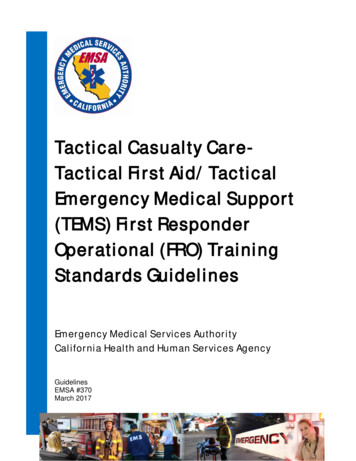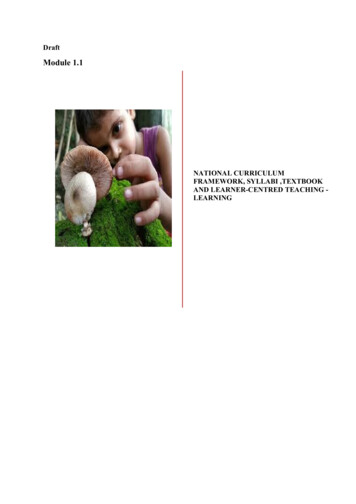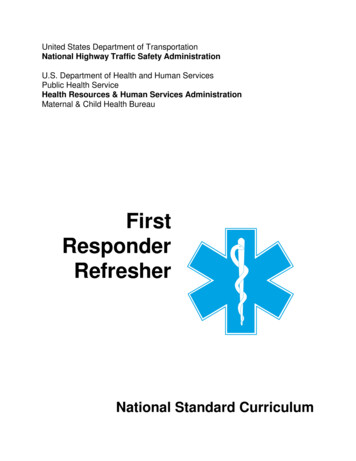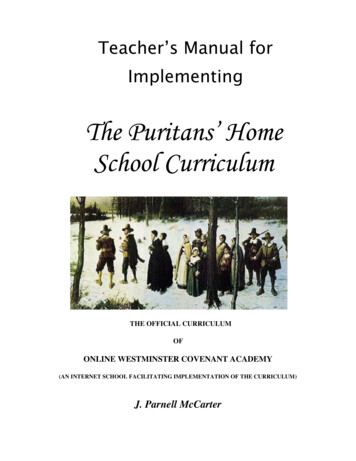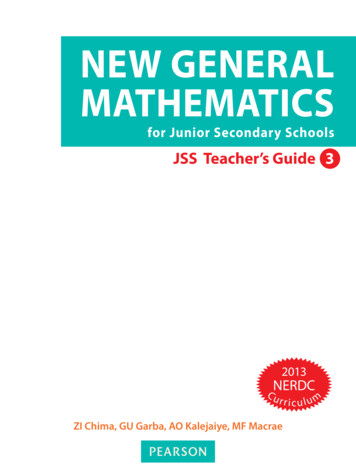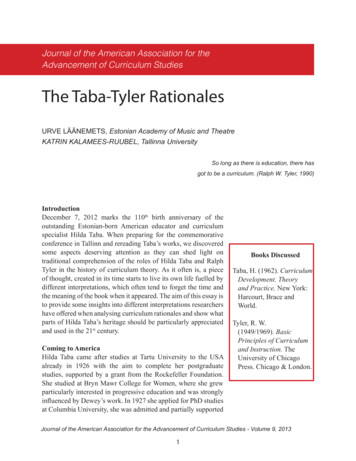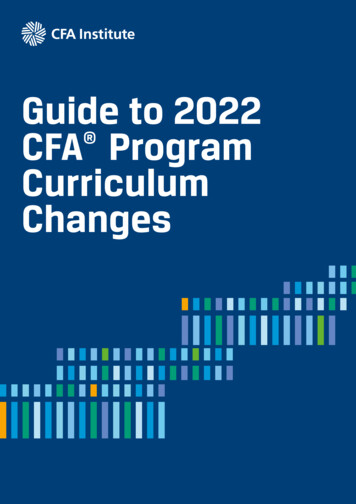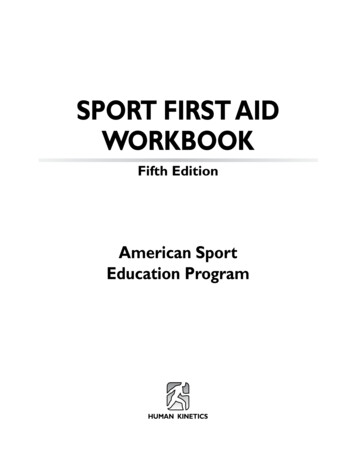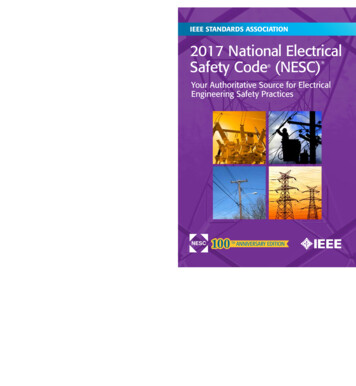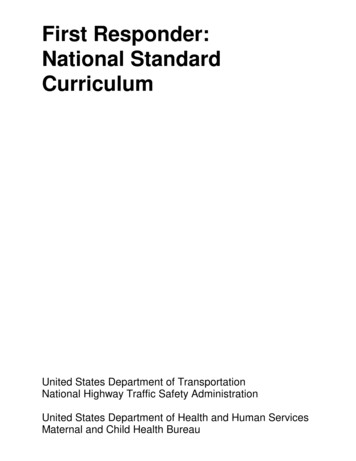
Transcription
First Responder:National StandardCurriculumUnited States Department of TransportationNational Highway Traffic Safety AdministrationUnited States Department of Health and Human ServicesMaternal and Child Health Bureau
First Responder: National Standard CurriculumInstructor's Course Guide---------------------------------------First Responder: National StandardCurriculumProject DirectorWalt Alan Stoy, PhD, EMT-PDirector of Educational ProgramsCenter for Emergency MedicineResearch Assistant Professor of MedicineUniversity of Pittsburgh School of MedicinePrincipal InvestigatorsGregg S. Margolis, MS, NREMT-PAssociate Director of EducationCenter for Emergency MedicineThomas E. Platt, NREMT-PCoordinator of EMS EducationCenter for Emergency MedicineMedical DirectorsNicholas H. Benson, MD, FACEPHerbert G. Garrison, MD, FACEPActing Chair, Department of Emergency MedicineEast Carolina University School of MedicineAssistant Professor of MedicineUniversity of Pittsburgh School of MedicineCurriculum Development GroupMichael O'KeefeBob W. BaileyState Training CoordinatorVermontChief, Office of EMSNorth CarolinaWilliam E. Brown, Jr., RN, REMT-PPhilip Dickison, REMT-PExecutive DirectorNational Registry of EMTsBasic Level CoordinatorNational Registry of EMTsSusan M. Fuchs, MD, FAAPAssociate Professor of PediatricsUniversity of Pittsburgh School of MedicineContract Number ----United States Department of TransportationNational Highway Traffic Safety AdministrationFirst Responder: National Standard Curriculumi
First Responder: National Standard CurriculumInstructor's Course Guide---------------------------------------Table of ContentsPreface . viiAcknowledgments.viiiProcess. xCardiopulmonary Resuscitation . xIntegration with the Blueprint. xiMedical Oversight Statement . xiiInstructor's Course GuideCurriculumHistory .Course Goals .Diagram of Educational Model .Course Design.How to Use the Curriculum and Lesson Plans .12459InstructorsAssessing Student Achievement .Philosophy Regarding Adult Learners.Some Principles of Adult Education .Continuing Education .14171820StudentsJob Description - First Responder. 21Continuing Education and Its Importance in Lifelong Learning . 23EnvironmentClassroom Environment .Clinical/Field Rotations.Maintaining Records.Credentialing .Program Evaluation .Facilities .Course Cost.-------------------------------------United States Department of TransportationNational Highway Traffic Safety AdministrationFirst Responder: National Standard Curriculum24242425252626iii
First Responder: National Standard CurriculumInstructor's Course ctor's Lesson PlansModule 1: PreparatoryLesson 1-1 Introduction to EMS Systems.1-1Lesson 1-2 The Well-Being of the First Responder .1-11Lesson 1-3 Legal and Ethical Issues.1-23Lesson 1-4 The Human Body.1-33Lesson 1-5 Lifting and Moving Patients .1-43Lesson 1-6 Evaluation: Preparatory .1-53Module 2: AirwayLesson 2-1 Airway .2-1Lesson 2-2 Practical Lab: Airway .2-21Lesson 2-3 Evaluation: Airway .2-27Module 3: Patient AssessmentLesson 3-1 Patient Assessment .3-1Lesson 3-2 Practical Lab: Patient Assessment .3-15Lesson 3-3 Evaluation: Patient Assessment .3-21Module 4: CirculationLesson 4-1 Circulation.4-1Lesson 4-2 Practical Lab: Circulation.4-9Lesson 4-3 Evaluation: Circulation.4-15Module 5: Illness and InjuryLesson 5-1 Medical Emergencies .5-1Lesson 5-2 Bleeding and Soft Tissue Injuries .5-19Lesson 5-3 Injuries to Muscles and Bones.5-33Lesson 5-4 Practical Lab: Illness and Injury.5-43Lesson 5-5 Evaluation: Illness and Injury .5-53Module 6: Childbirth and ChildrenLesson 6-1 Childbirth .6-1Lesson 6-2 Infants and Children .6-11Lesson 6-3 Practical Lab: Childbirth and Children .6-25Lesson 6-4 Evaluation: Infants and Children .6-31iv-------------------------------------United States Department of TransportationNational Highway Traffic Safety AdministrationFirst Responder: National Standard Curriculum
First Responder: National Standard CurriculumInstructor's Course Guide---------------------------------------Module 7: EMS OperationsLesson 7-1 EMS Operation .7-1Lesson 7-2 Evaluation: EMS Operations .7-11AppendicesAppendix A Functional Job Analysis . A-1Appendix B BLS HeartSaver Information and Skill Sheets. B-1Appendix C Adult and Pediatric Basic Cardiac Life Support Guidelines . C-1Appendix D Enrichment Lesson Plan . D-1Appendix E Remediation Sheet . E-1-------------------------------------United States Department of TransportationNational Highway Traffic Safety AdministrationFirst Responder: National Standard Curriculumv
First Responder: National Standard CurriculumInstructor's Course ---------------------------------United States Department of TransportationNational Highway Traffic Safety AdministrationFirst Responder: National Standard Curriculum
First Responder: National Standard CurriculumInstructor's Course -------------------------------United States Department of TransportationNational Highway Traffic Safety AdministrationFirst Responder: National Standard Curriculumvii
First Responder: National Standard CurriculumInstructor's Course x F Patient Assessment Flow Sheets . F-1Appendix G National EMS Education and Practice Blueprint .G-1Appendix H Final Practical Skills Examination . H-1viii-------------------------------------United States Department of TransportationNational Highway Traffic Safety AdministrationFirst Responder: National Standard Curriculum
First Responder: National Standard CurriculumInstructor's Course -------------------------------United States Department of TransportationNational Highway Traffic Safety AdministrationFirst Responder: National Standard Curriculumix
First Responder: National Standard CurriculumInstructor's Course eThe National Highway Traffic Safety Administration (NHTSA) has assumedresponsibility for the development of training courses that are responsive to thestandards established by the Highway Safety Act of 1966 (amended). Since thesetraining courses are designed to provide national guidelines for training, it is NHTSA'sintention that they be of the highest quality and be maintained in a current and up-todate status from the point of view of both technical content and instructional strategy.To this end, NHTSA supported the current project which involved revision of theEmergency Medical Services: First Responder Training Course, deemed of high valueto the states in carrying out their training programs. This course revision is being cosponsored by the Maternal and Child Health Bureau, U.S. Department of Health andHuman Services. Additional funding for this project was provided as in-kind services ofthe Center for Emergency Medicine and through a Grant from the PittsburghEmergency Medicine Foundation. This course is one of a series of courses making upa National EMS education program for out-of hospital care. The First Responder is adesignated level of emergency medical care provider as outlined by the National EMSEducation and Practice Blueprint.The First Responder is an integral part of the Emergency Medical Services System.The term "first responder" has been applied to the first individual who arrives at thescene regardless of the individual's type of credential. It is the goal of the FirstResponder: National Standard Curriculum to provide students with the core knowledge,skills and attitudes to function in the capacity of a first responder. The First Responderuses a limited amount of equipment to perform initial assessment and intervention andis trained to assist other EMS providers. This level of provider is not intended to beutilized as the minimum staffing for an ambulance. Enrichment programs andcontinuing education will help fulfill other specific needs for the First Respondertraining.It is recognized that there may be additional specific education that will be required ofFirst Responders who operate in the field. It is also recognized that practice mightdiffer from locality to locality, and that each training program, or system should identifyand provide additional training requirements. Consistent with the intent and design ofthe National EMS Education and Practice Blueprint, some EMS systems will incorporateadditional skills into the scope of practice of the First ited States Department of TransportationNational Highway Traffic Safety AdministrationFirst Responder: National Standard Curriculum
First Responder: National Standard CurriculumInstructor's Course ledgmentsFrom the very beginning of this revision project, the Department of Transportationrelied on the knowledge, attitudes, and skills from hundreds of experts. Theseindividuals sought their own level of involvement and contribution toward accomplishingthe goals of this project. These contributions varied from individual to individual, andregardless of the level of involvement, everyone played a significant role in thedevelopment of the curriculum. It is essential that those who have assisted with theachievement of this worthy educational endeavor be recognized for their efforts. Forevery person named, there are 50 or more individuals who should be identified for theircontributions. For all who have contributed, named and unnamed, thank you forsharing your vision. Your efforts have helped assure that the educational/trainingneeds of First Responders are met so that they can provide appropriate and effectivepatient care.Special thanks for the knowledge, expertise, and dedication given to this project by theProject Director, Co-Principal Investigators, Co-Medical Directors, and all the membersof the Curriculum Development Group.NHTSA would also like to recognize the following individuals and/or organizations fortheir significant contributions to this project:National OrganizationsNational Registry of EMTsWilliam Brown, RNPhil Dickison, REMT-PState of North CarolinaGovernor James B. Hunt, Jr.Department of Human ResourcesDivision of Facility ServicesOffice of Emergency MedicalServicesBob W. Bailey, ChiefEd BrowningNicholas Benson, MD, FACEPNorth Carolina State Highway PatrolCol. R.A. BarefootLt. Col. C. R. WilkinsMaj. R. D. JenkinsFirst Sergeant C. L. GarnerSergeant G. D. HayesTrooper J. D. HendersonTrooper E. C. ManessTrooper G. W. StarlingSergeant M. J. d States Department of TransportationNational Highway Traffic Safety AdministrationFirst Responder: National Standard Curriculumxi
First Responder: National Standard CurriculumInstructor's Course Guide--------------------------------------State of MinnesotaGovernor Arne CarlsonMinnesota State Board of TechnicalCollegesCarole M. Johnson, PhD,ChancellorAdam D. Pishura, DirectorFire/EMS TrainingMike Wilcox, MD, MedicalAdvisorJoe Grafft, MS, EMS SpecialistCharles G. CogginsMorris S. Miller, RNNona Niemeier, BA, NREMT-AGerald W. OttoBrett A Rima, EMT-PJames V. Sinkbeil , MS,NREMT-AEric M. Weller, BS, NREMTCenter for Emergency MedicinePaul M. Paris, MD, FACEPDonald Goodman, MBADebra A. Barclay, EMT-PPamela WestfallBonnie RolisonCheryl Butler,Greg Lipson, MBAPittsburgh Emergency MedicineFoundationPhil Davidson, PresidentIndividualsMike Smith, REMT-P for hisinvaluable assistance indeveloping Affective Objectives.Robert Elling, MPH, EMT-P fordeveloping the patient caresimulations.Queen of Peace HospitalSister Jean JuenemannDiane HrabeNoreen SeurerFood Service DepartmentJan Fazio for her exceptionalediting of the Final DraftSt. Wenceslaus School2nd Grade ClassAnn ChristyPamela TheisZane Johnson, MAB Enterprisesfor providing pocket masks forthe Minnesota Pilot TestAudrey and Katelyn ZurnJoint Powers Board South CentralMinnesota EMS Regional -----------United States Department of TransportationNational Highway Traffic Safety AdministrationFirst Responder: National Standard Curriculum
First Responder: National Standard CurriculumInstructor's Course sThe First Responder: National Standard Curriculum was designed and developed by aCurriculum Development Group (CDG) of emergency medicine and education experts.These experts met in person and via teleconference to review, edit, and critique thedevelopmental document. The Co-Medical Directors reviewed, critiqued, and approvedthe medical content of the curriculum. The Co-Principal Investigators and the ProjectDirector actually put the "pen-to-paper" once the objectives and format were approvedby the CDG.Two pilot tests were conducted, one in Raleigh, North Carolina (representingurban/metropolitan First Responders), and the other in New Prague, Minnesota(representing rural First Responders). Eleven students participated in the NorthCarolina Pilot, and 39 students participated in the Minnesota Pilot. The project teamwas able to view and modify the content of the curriculum based on insight gatheredfrom the pilot test process.The National Registry of EMTs designed and developed modular examinations and thefinal evaluation tools that were used in the pilot test project. They also completed thetabulation and evaluation of the test scores.Cardiopulmonary ResuscitationThis curriculum contains many of the knowledge and skill objectives of cardiopulmonary resuscitation. In order to maintain an up-to-date curriculum, the didacticmaterial has not been reproduced. Instructors must utilize the current American HeartAssociation Guidelines and teaching strategies as the basis for instruction in Module 2:Airway and Module 4: Circulation. In some states, or EMS systems, issuance of a"successful completion" card for CPR may be required to practice as a FirstResponder. Meeting the objectives of this program provides the First Responder withthe ability to perform CPR; but the program does not contain all of the prevention andrecognition material within the guidelines established by the American HeartAssociation. During the program, if issuance of a CPR card is desirable or required,additional information must be added to the program. Testing and/or other courserequirements for issuance of a specific agency's CPR card will need to be completedwithin the First Responder Training Program. Requirements for issuing a successfulcompletion card may be obtained from the local CPR training agency or your StateOffice of Emergency Medical ed States Department of TransportationNational Highway Traffic Safety AdministrationFirst Responder: National Standard Curriculumxiii
First Responder: National Standard CurriculumInstructor's Course ation with the BlueprintThe National EMS Education and Practice Blueprint (Appendix BP), adopted through anational peer review and consensus process, guided the development of thiscurriculum. This constitutes the minimum national knowledge and skill competenciesfor a First Responder, who is identified in the Blueprint as an individual who:".uses a limited amount of equipment to perform initialassessment and intervention and is trained to assist otherEMS providers."As part of a consistent, organized, state-wide approach to the education andcertification/licensure of First Responders, state EMS offices may wish to supplementthis minimum national standard curriculum with additional knowledge and skills.However, to be consistent with the intent and philosophy of the National EMSEducation and Practice Blueprint, state-wide additions to the First Responder'seducation and scope of care should reflect the Blueprint's continuum of knowledge andskills.Each level of knowledge and skill includes all previous levels. If knowledge or skillitems are "out of synch" with the logical continuum, the utility and value of the Blueprintis significantly decreased. For example, in the Core Component of CIRCULATION,Automated Defibrillation is the next skill above First Responder and comes beforePneumatic Anti-Shock Garment (PASG). Therefore, if the PASG is a skill added by astate to the First Responder Program, consistency with the Blueprint would require thatAED be included also.When knowledge and skills are added to the First Responder's scope of care, theadditional information should be consistent with the corresponding levels of the nexthigher level of national curriculum. For instance, if a state requires automated externaldefibrillation at the First Responder level, the corresponding lesson from the 1994EMT-Basic: National Standard Curriculum should be used thus assuring a logical,inclusive continuum of education.Vital signs, supplemental oxygen, automated defibrillation, simple immobilization andother knowledge or skills may be added to the First Responder program and remainconsistent with the Blueprint providing they are allowable by the state EMS office, occurin the same order identified in the Blueprint continuum, and reflect the content of the1994 EMT-Basic: National Standard -United States Department of TransportationNational Highway Traffic Safety AdministrationFirst Responder: National Standard Curriculum
First Responder: National Standard CurriculumInstructor's Course l Oversight StatementMedical oversight should exist for the First Responder to help ensure quality care. Thisshould occur in the context of the local EMS System's medical oversight. The primaryrole of the physician will be to supervise the development of patient care protocols andto respond to questions about patient care issues.Quality improvement is also a required component of EMS training. The role of medicaloversight is paramount in ensuring the highest quality out-of-hospital care. Medicaldirectors should work with individuals and systems to review out-of-hospital cases andachieve a sound method of continuous quality nited States Department of TransportationNational Highway Traffic Safety AdministrationFirst Responder: National Standard Curriculumxv
First Responder: National Standard CurriculumInstructor's Course ulumHistoryThe First Responder: National Standard Curriculum was last reviewed in the late1970s. The current revision came about as a result of the National Highway TrafficSafety Administration's (NHTSA) January 1990 Consensus Workshop on EmergencyMedical Services Training Programs. Participants discussed the national trainingcurricula needs of Emergency Medical Service (EMS) providers. Using a nominalgroup process, the participants identified the top priority needs for EMS training in theUnited States.The top priorities identified at that meeting led to issuance of a Request for Proposal(RFP) by NHTSA to revise the Emergency Medical Service: First Responder TrainingCourse based upon the 1994 EMT-Basic: National Standard Curriculum and theNational EMS Education and Practice Blueprint. The following priorities from the 1990consensus workshop recommendations played a directing role in the revision of thisFirst Responder Curriculum:!Review and development of a blueprint/model and core curriculum for eachprovider level, based upon task analysis focusing on field impact (evaluatingpositive/negative outcomes) and the most utilized knowledge and skill areas.Identify "need to know" versus "nice to know" content. Conduct an analysis ofinterventions and outcomes for both the patient and the care provider. (Whatare we really doing in EMS? What's making a difference? Define what we wantto do).!Establish a Physician Board to review and approve all medical curriculumcontent.!Emphasize an assessment-based format rather than a diagnostic-based formatfor all levels and all ages.!Ensure that there is adequate focus on primary skills of assessment and ABCs inall provider levels (with emphasis on airway).!Include an objective assessment of all published studies in peer journals whenrevising ted States Department of TransportationNational Highway Traffic Safety AdministrationFirst Responder: National Standard Curriculum1
First Responder: National Standard CurriculumInstructor's Course ize rescuer and patient safety components, including infection control, inall curricula.!Ensure that out-of-hospital providers have adequate skills to care for childrenand infants by integrating information throughout the curricula at all levels, withinthe established course items.!Build in clearly defined medical control for all levels, not just EMT-Paramedic.!Utilize measurable educational objectives (knowledge, skills, judgement) todetermine individuals' learning needs and duration of training program.!Develop a nationally acceptable core curriculum for each provider level, with amechanism for customizing for local needs.!Place curriculum revision emphasis on EMT-A and First Responder courses.!Revise basic course to be no more than 110 hours in length.!Add automated defibrillation (fully automatic and semi-automatic) for CPR byEMTs and First Responders.!Develop an integrated/situational (real-world) approach for EMT training.!Develop a mechanism for consensus on EMS education among national groups.!Evaluate delivery methods of training.!Include sufficient information in basic EMT-A curriculum to comply withhazardous materials (HAZMAT) worker protection standard.!Include more on medical emergencies as opposed to trauma (including airway).Course GoalsThis instructor's course guide has been designed and developed to assist the coursecoordinator, instructors, and others in planning, managing and teaching the FirstResponder: National Standard Curriculum. The goals and objectives of this curriculumare to improve the quality of emergency medical care.2-------------------------------------United States Department of TransportationNational Highway Traffic Safety AdministrationFirst Responder: National Standard Curriculum
First Responder: National Standard CurriculumInstructor's Course Guide--------------------------------------This course is designed to instruct a student to the level of First Responder, whoserves as a vital link in the chain of the health care team. This curriculum includesskills necessary for the individual to provide emergency medical care with a limitedamount of equipment. Specifically, after successful completion of the program, thestudent will be capable of performing the following functions at the minimum entry level:!Recognize the seriousness of the patient's condition or extent of injuries toassess requirements for emergency medical care;!Administer appropriate emergency medical care for life threatening injuriesrelative to airway, breathing and circulation;!Perform safely and effectively the expectations of the job description.It is obvious that First Responders provide a service in an environment requiringspecial skills and knowledge. They also serve as liaisons with other emergencyservices. This course provides an introduction to these concepts. Individualorientation to the specific systems and services with which the First Responder will beaffiliated is necessary to achieve a full level of competency within a specificorganization.The entire curriculum is surrounded by continuing education, which is designed toreflect two primary goals. First, during the instruction of the First Responder: NationalStandard Curriculum, additional continuing education in related content may beprovided. Second, continuing education is an integral component of any educationalprocess and the First Responder should be committed to continuous improvement ofknowledge and skills.-------------------------------------United States Department of TransportationNational Highway Traffic Safety AdministrationFirst Responder: National Standard Curriculum3
First Responder: National Standard CurriculumInstructor's Course Guide--------------------------------------FIRST RESPONDER: NATIONAL STANDARD CURRICULUMDIAGRAM OF EDUCATIONAL MODELCONTINUINGEDUCATIONCONTINUINGEDUCATIONI. PREPARATORYIntroduction to EMS SystemsThe Well-Being of the FirstResponderLegal and Ethical IssuesThe Human BodyLifting and MovingII. AIRWAYAirwayIV. CIRCULATIONIII. PATIENT ASSESSMENTV. ILLNESS ANDINJURYCirculationPatient AssessmentMedical EmergenciesBleeding and SoftTissue InjuriesInjuries to Musclesand BonesVI. CHILDBIRTH ANDCHILDRENChildbirthInfants and ChildrenVII. EMS OPERATIONSEMS ------------------------------------United States Department of TransportationNational Highway Traffic Safety AdministrationFirst Responder: National Standard Curriculum
First Responder: National Standard CurriculumInstructor's Course Guide---------------------------------------Course DesignModule 1 PreparatoryLesson 1-1Introduction to EMS SystemsFamiliarizes the First Responder candidate with the
The First Responder is an integral part of the Emergency Medical Services System. The term "first responder" has been applied to the first individual who arrives at the scene regardless of the individual's type of credential. It is the goal of the First Responder: National Standard Curricu
